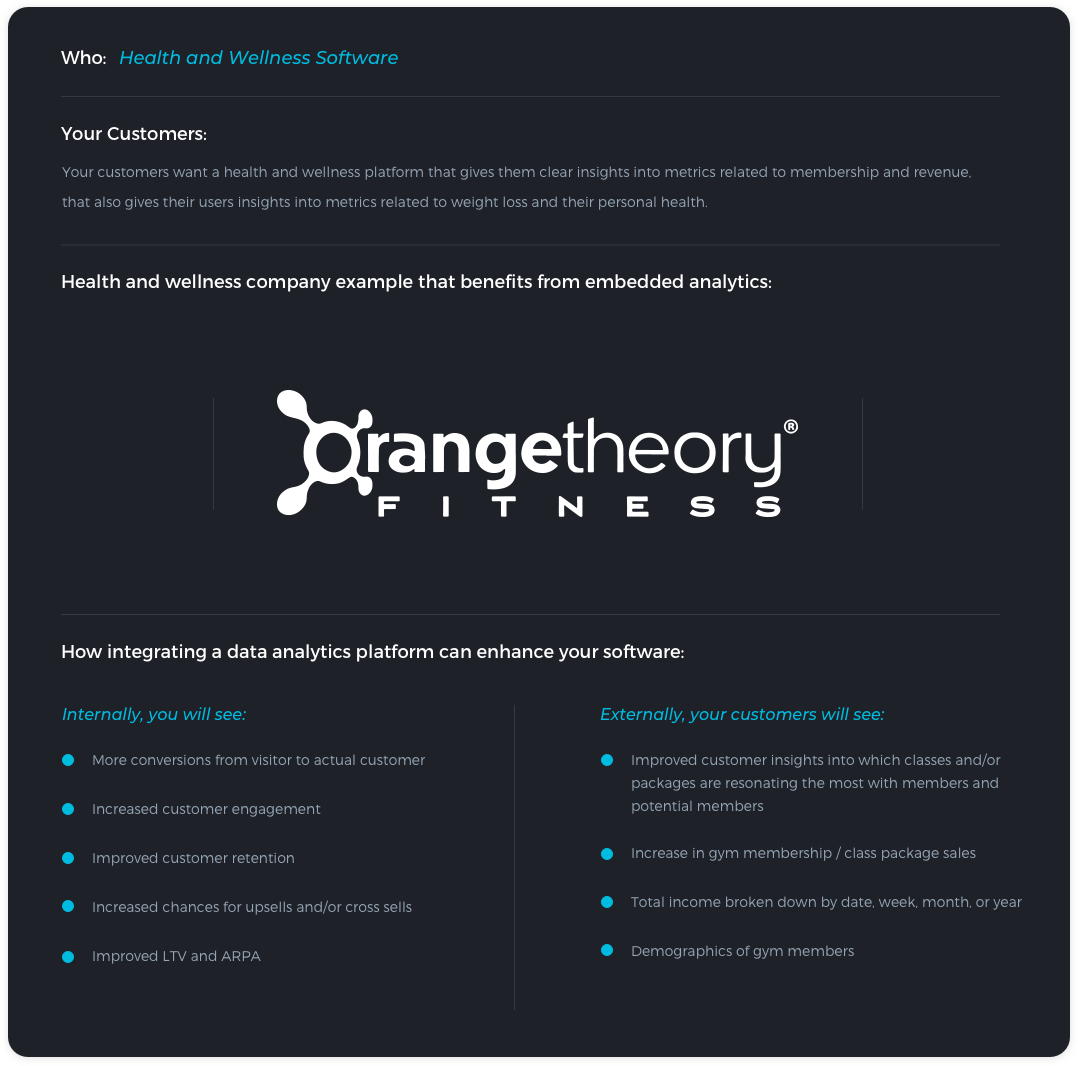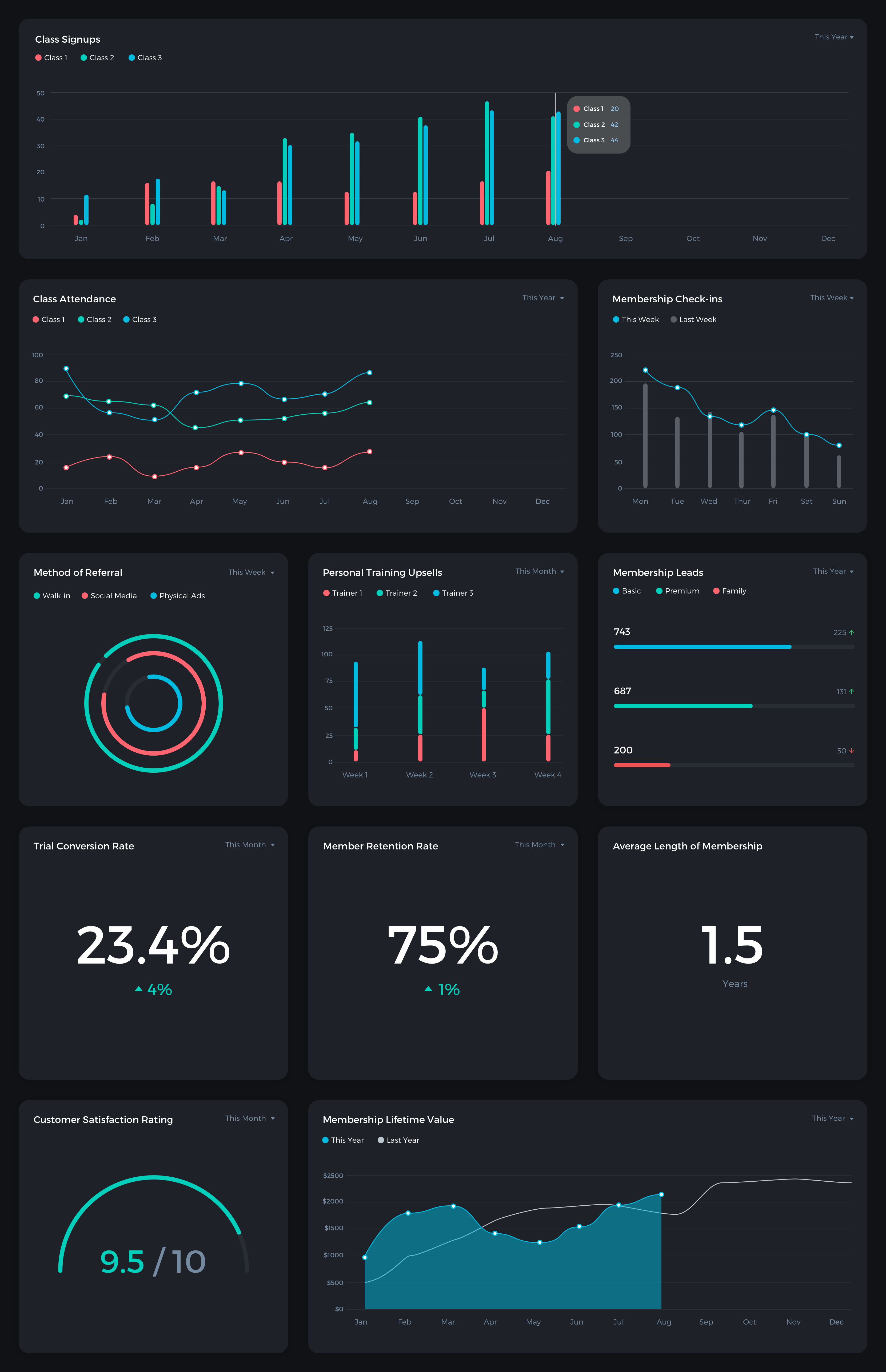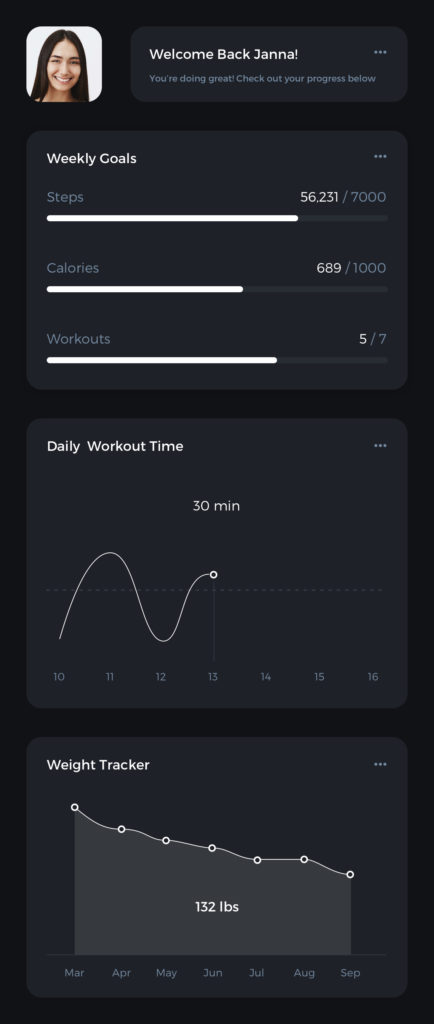Would you believe that the health and wellness industry is worth an estimated $4.2 trillion dollars? According to the Global Wellness Institute, the health and wellness industry grew 12.8% in just two years from 2015-2017, shows no signs of slowing down, and “provides fresh evidence that wellness remains one of the world’s biggest and fast-growing industries.”
In other words, if you’re a software developer creating applications in this space, there is no time like the present to get involved in product creation for this industry. The secret to success for app development in this space? Embedded analytics.
For today’s purposes, we’re focusing on application development for fitness studios, and why embedded analytics are so critical to your company’s success. Here’s the harsh reality that many fitness studios still face – in January their numbers are booming thanks in part to New Year’s Resolutions from the masses to make this the year they get healthy.
Then come December, if not sooner, membership has fallen dramatically and owners are scrambling to bring in new sign ups. Sure, the numbers may go back up with the new year marketing push once more, but how can a fitness studio see financial gains all year long?
One of the things they need to get the answer to this question is data. In fact, your software may be just what the doctor ordered. That is, as long as it features customer facing metrics that show studios things like which classes are getting the most sign ups, attendance trends by time of day and/or day of week, how many people purchase memberships after free trials, and so on.
Does This Sounds like You?

Goals and Current Challenges of Fitness Studio Owners
What fitness studio owners need is software that breaks down the ins and outs of their business so they know where to focus their marketing efforts, which classes are doing well, how to bring in more clients, and where the bottlenecks are preventing them from achieving more revenue. The goal is of course to bring in more money, but it’s also to build a loyal following of fans that will continue coming back and advocating for the studio.
In addition, another goal fitness studio owners seek to achieve is to actually help their customers with their fitness and wellness goals. One way to assist fitness studio customers with that is to also provide members with insights into how they are progressing with those goals by way of a user interface that shows them where they are succeeding and where they can improve.
Your health and wellness software should give the fitness studio owner, and their customers all the data they need to determine their progress on their goals. With that in mind, below are the metrics your embedded analytics dashboard should be tracking for both the studio owner, and for the studio’s members.
Metrics You Should Be Tracking for the Studio Owner
At a minimum, your software should enable fitness studio owners to track:
Class signups: This metric enable fitness studio owners to answer questions like:
- How many people signed up for a class?
- How many attended a class and never returned?
- Which classes have the most/least attendance?
- Which days are the most popular with students?
Class attendance: Just because people sign up for a class, doesn’t mean they attend. Which classes have chronic low attendance? This metric can help studio owners hone in on classes that their members engage the most with, and which ones may need revisions in time, teacher, or format.
Membership numbers: This tells a fitness studio how much recurring revenue they can anticipate. When broken down by month it also lets owners know if there are surges in membership sign ups or cancellations.
In addition to membership numbers, studios need to track payment methods so they know if people are paying monthly, up front, or have only paid for a specified amount of time. These metrics allow studio owners to make internal changes based on concrete numbers
Membership check-ins/ membership usage: Even if they never attend a class, how many customers are physically coming to the fitness studio? If members aren’t even showing up, it could be an indicator they might be considering cancelling their membership.
Method of referral/marketing source: How did the customer come to know about the gym? Were they referred by a member, a walk-in, an advertisement, social media, etc…
Upsells: One of the upsells fitness studios sometimes offer is personal training for an additional fee. You should be tracking when customers take advantage of upsells.
Number of leads: How many people are potential leads for the fitness studio at any given time?
Conversion rates: This measures a fitness studio’s ability to turn a lead into a trial member, or to turn a trial member into a paid member.
Retention rate: How many people stay on as members within an allotted time period?
Average length of membership: This tells a fitness studio the average amount of time it can retain its current members.
Customer satisfaction: How happy are customers with their current fitness studio membership?
Member lifetime value: Fitness studios need to measure the value of a customer throughout the entire time of their membership.

Health and Wellness Metrics You Should be Tracking for the Members
The customers of the fitness studios also have metrics they want to measure. With the increase in popularity of fitness wearables like the FitBit, Garmin’s Vivosmart and Vivofit, and other health tracking bracelets/bands, gym members want this data to help them track their fitness goal progress.
Just a few of the metrics they want to track include, but aren’t limited to:
- Calories burned for classes/workouts: If a customer takes a pilates class for example, they want a record of how many calories they will burn during the class time. Or if instead they spent an hour on the treadmill, they want to know how many calories were burned for the time and distance they worked out.
- Workout stats in real time: How much time did they work out this week? This month? This year? And, how many calories were burned in that time?
- Personal progress: What was their beginning weight and their current weight? How much further do they need to go to achieve their weight loss goals?
- Number of workouts performed: Some users set a goal for number of workouts completed in a given amount of time. This metric allows them to see how they are doing in achieving this goal.

Options for Embedded Analytics for Your Health and Wellness Software
Now that you have a better understanding of the metrics your fitness studio customers, and their users are looking for, how can you deliver customer facing metrics to them? After researching the options available to you, you’ll find you mainly have two choices:
- You could build your embedded analytics solution from scratch, or
- You could purchase a product that is ready-made, and implement it upon purchase
When you build your embedded analytics solution from scratch the following things can happen:
- It can take a lot longer than you anticipated
- The project can be significantly more expensive than you are prepared to budget for – and it can easily go over budget once you get into it
- Maintenance and updates will cost additional time and money
- Building your solution may reach a point where it’s dead in the water and never gets completed.
On the other extreme of the spectrum is buying a ready-made product that can be implemented out of the box. With this option, software developers find:
- The function and usability is limited
- The customer-facing metrics your customers need/want are not readily available
- However, the out of the box product is cheaper than the alternative, and ready for use as soon as you buy it.
Now, you may be asking yourself, is there a happy medium?
The answer thankfully is yes. Enter Keen, the embedded analytics API that gives you the best of both worlds. You can build a custom analytics solution perfect for your customers and their end users, without shelling out time, money, and resources you simply don’t have.
When you combine your health and wellness software with Keen’s platform, you can create a data model and front-end experience designed to your specific needs. And, the build will be as simple as copy and paste. The best part is you will have Keen’s seasoned experts by your side every step of the way.
You don’t even need a mock-up when you’re ready to start. Just bring your ideas to Keen’s data visualization experts, and they will help you in creating an impressive dashboard that is perfect for your customers, and end users.
Bottom line, Keen is the solution you’ve been searching for. Don’t take our word for it though. Request your demo today, and see just how easy it is to get started!




